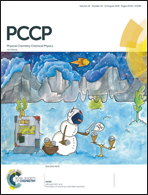‘Reverse’ Hofmeister effects on the sol–gel transition rates for an α-helical peptide–PEG bioconjugate
Abstract
We examine the dynamics of the sol–gel transition for end-functionalized linear- and 4-arm-peptides bioconjugated to poly-ethylene glycol (PEG) in aqueous environments with increasingly chaotropic (Cl− < Br− < I−) anions. A 23-amino acid peptide sequence is rationally designed to self-assemble upon folding into the ordered α-helical conformation due to the hydrophobic effect. We use Attenuated Total Reflection-Fourier Transform Infrared Spectroscopy (ATR-FTIR) to quantify the ensemble average reversible secondary structure transitions as a function of electrolyte concentration and specific ion effects along the Hofmeister series. Subsequently, microrheology is used to quantify the kinetics of the gelation process, as it relates to folding and specific ion interactions. Our key findings were non-intuitive. We observe the faster evolution of the gel transitions in systems with more chaotropic anions. For our peptides in aqueous solution, “water-structuring” ions yield faster assembly behavior with a viscoelastic exponent, n, closer to unity representing self-assemblies that are Rouse-like. In contrast, ions that are “water-breaking” resulted in smaller viscoelastic exponents where self-assembly dynamics result in a viscoelastic exponent that suggests polymer entanglements.



 Please wait while we load your content...
Please wait while we load your content...
